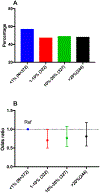Blood pressure reduction and outcome after endovascular therapy with successful reperfusion: a multicenter study
- PMID: 31806668
- PMCID: PMC7998040
- DOI: 10.1136/neurintsurg-2019-015561
Blood pressure reduction and outcome after endovascular therapy with successful reperfusion: a multicenter study
Abstract
Background: Elevated systolic blood pressure (SBP) after mechanical thrombectomy (MT) correlates with worse outcome. However, the association between SBP reduction (SBPr) and outcome after successful reperfusion with MT is not well established.
Objective: To investigate the association between SBPr in the first 24 hours after successful reperfusion and the functional and safety outcomes of MT.
Methods: A multicenter retrospective study, which included 10 comprehensive stroke centers, was carried out. Patients with acute ischemic stroke and anterior circulation large vessel occlusions who achieved successful reperfusion via MT were included. SBPr was calculated using the formula 100×([admission SBP-mean SBP]/admission SBP). Poor outcome was defined as a modified Rankin Scale (mRS) score of 3-6 at 90 days. Safety endpoints included symptomatic intracerebral hemorrhage, mortality, and requirement for hemicraniectomy during admission. A generalized mixed linear model was used to study the association between SBPr and outcomes.
Results: A total of 1361 patients were included in the final analysis. SBPr as a continuous variable was inversely associated with poor outcome (OR=0.97; 95% CI 0.95 to 0.98; p<0.001) but not with the safety outcomes. Subanalysis based on reperfusion status showed that SBPr was associated with lower odds of poor outcome only in patients with complete reperfusion (modified Thrombolysis in Cerebral Infarction (mTICI 3)) but not in patients with incomplete reperfusion (mTICI 2b). When SBPr was divided into categories (<1%, 1%-10%, 11%-20%, >20%), the rate of poor outcome was highest in the first group.
Conclusion: SBPr in the first 24 hours after successful reperfusion was inversely associated with poor outcome. No association between SBPr and safety outcome was found.
Keywords: blood pressure; stroke; thrombectomy.
© Author(s) (or their employer(s)) 2020. No commercial re-use. See rights and permissions. Published by BMJ.
Conflict of interest statement
Competing interests: AS has honoris for consulting for Penumbra and Cerenovus. M-NP received honoraria; modest; received speakers’ honoraria from Siemens Healthineers.SQW reports U24NS107235- 01 NIH/NINDS StrokeNET Site Co-I. The other authors report no conflicts.
Figures


References
-
- Qureshi AI. Acute hypertensive response in patients with stroke: pathophysiology and management. Circulation 2008;118:176–87. - PubMed
-
- Anadani M, Orabi Y, Alawieh A, et al. Blood pressure and outcome post mechanical thrombectomy. J Clin Neurosci 2019;62:94–9. - PubMed
-
- Anadani M, Orabi MY, Alawieh A, et al. Blood pressure and outcome after mechanical thrombectomy with successful revascularization. Stroke 2019;50:2448–54. - PubMed
-
- Goyal N, Tsivgoulis G, Iftikhar S, et al. Admission systolic blood pressure and outcomes in large vessel occlusion strokes treated with endovascular treatment. J Neurointerv Surg 2017;9:451–4. - PubMed
Publication types
MeSH terms
Grants and funding
LinkOut - more resources
Full Text Sources
Medical
